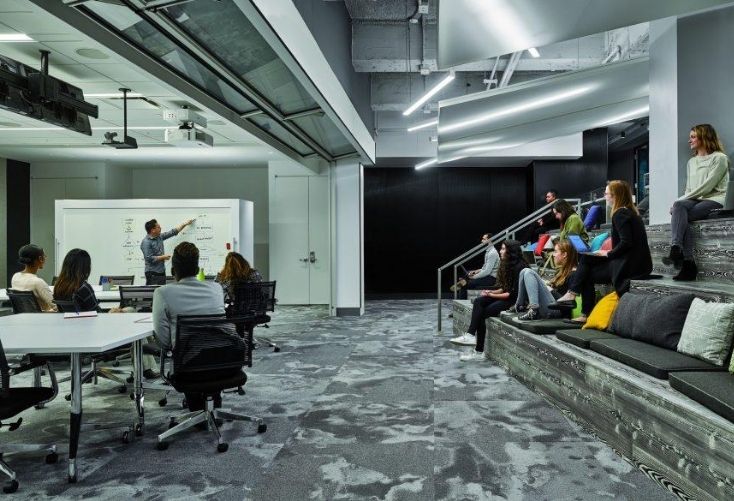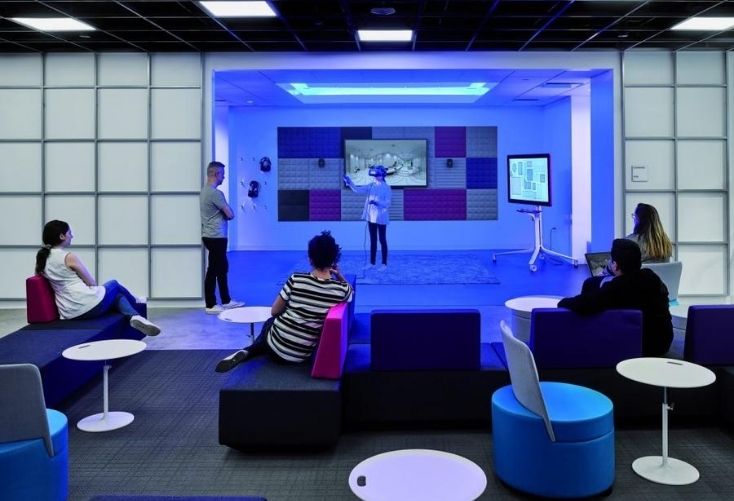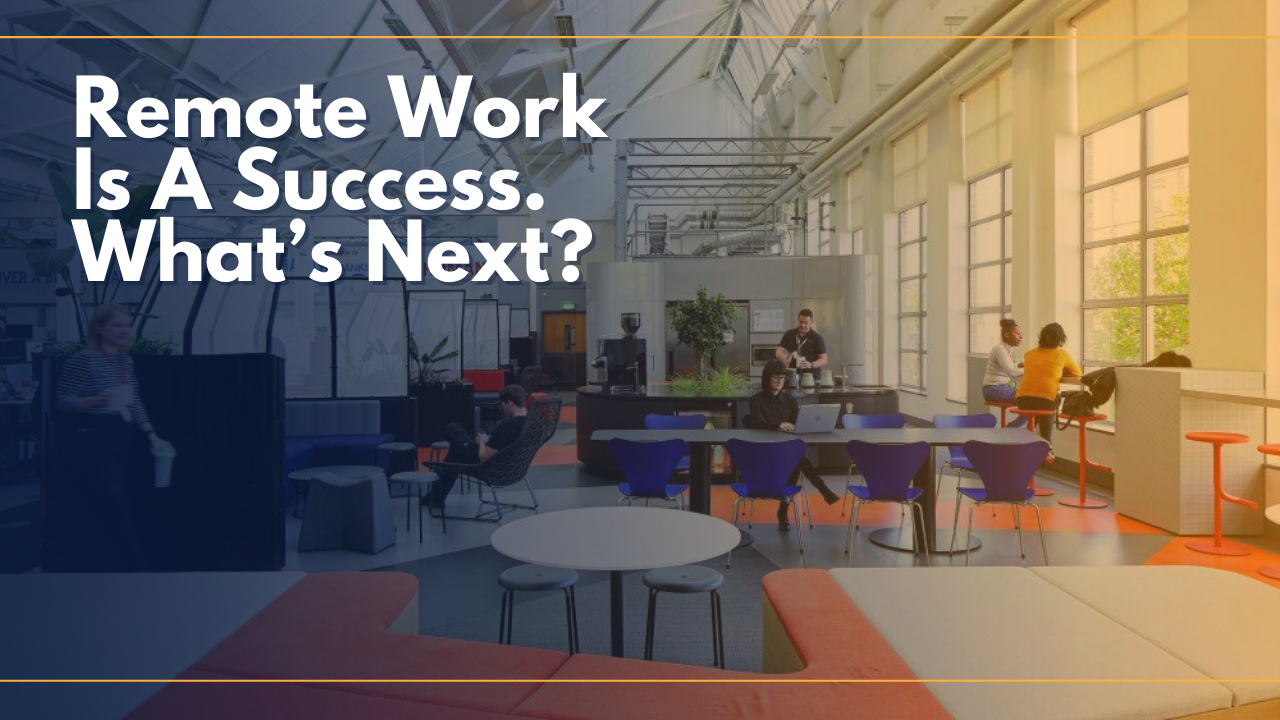- Out-of-office is now the business normal. So what comes next, and how will the corporate workplace model respond?
- Amid a proliferation of return-to-work playbooks, the difficult truth is that nobody knows what the long-term implications on real estate will be.
- However, we can be reasonably confident that the future of work revolves around greater worker mobility.
This article was originally published on Work Design Magazine.
Nearly 50 percent of full-time knowledge workers may be out-of-office on a regular basis. How then, will the corporate workplace model respond?
In the last few months, the discussion on the COVID-19 pandemic and its impact to the workplace has evolved quickly. Early conversations on optimizing remote work functionality have faded, and in their place a proliferation of return-to-work playbooks emerged.
More recently, questions surrounding the post-pandemic workplace have appeared on the horizon and our industry has begun to focus on the short-term recovery measures that may ultimately evolve into permanent mainstays. The difficult truth that we in the design community must face (in the absence of a crystal ball), is that despite all the dialogue to date, we remain in the dark on the ultimate resolution of the crisis. Questions abound on the long-term real estate implications and substantive design solutions.
There are, however, a few projections we can make with a reasonable level of confidence. One such prediction revolves around the future of worker mobility.
Suggested Reading: What Does Working Remotely Mean?
Even in a post-vaccine world, remote work will undoubtedly increase by a substantial margin, relative to pre-pandemic levels.
By some aggressive estimates, nearly 50 percent of full-time knowledge workers may be out-of-office on a regular basis. How then, will the corporate workplace model respond? The following thoughts seek to explore this question.

Posit #1: Companies must reckon with a future in which many of their employees choose to work from a location other than their primary office. Ultimately, this will force employers to select from a range of disruptive real estate outcomes, which might include:
- A willingness to accept an impactful decline in space utilization as the traditional office model is de-densified, where on-site employees would have significantly more room in which to operate.
- An aggressive reduction of lease commitments and/or divestiture of owned assets to counter the anticipated drop in occupancy. In an extreme case, companies could choose to abandon brick-and-mortar almost entirely, opting for the occasional co-working solution when congregation is needed. Alternatively, organizations might adopt a hub-and-spoke/constellation model of physical space to build redundancy.
- A hybrid of these scenarios, in which the office model is reinvented, and targets functions focused on collaboration/learning. In this case, focused work would occur remotely, as has been proven feasible at large scale in recent months.
In overcoming these changes, facilities and operations personnel clearly have much to consider. Before making any decisions, a thorough understanding of team structure, dynamics, and workflows is necessary to determine who really needs to be on-site and with what frequency. The feasibility of any response will vary by industry, of course. An attorney working autonomously might have little reason to rush back to the office, for instance, while a cluster of R&D personnel might view co-location as essential.
The most likely outcome, it seems, is a hybrid. Cynics of full-scale de-densification will point to the willingness of the labor force to return to skyscrapers post-9/11. In contrast, advocates of a true paradigm shift will suggest this event is a one-of-a-kind disruptor – a catalyst bringing the fourth industrial revolution alongside an increasingly automated workforce. Regardless of the final outcome, we must all learn from this period if we are to safeguard a more resilient future.

Posit #2: As a larger portion of the workforce remains off-site on a given day, companies will have to radically redefine their collaboration protocols to maintain full, equitable participation.
One of the unintended consequences of our current collaboration model is that it has leveled the information playing field to some degree. Gone are the informal chats in the doorway, the overheard nugget of wisdom, the water cooler exchanges. This sacrifice certainly dilutes the breadth of knowledge diffusion in the workplace, but because we are all currently remote, no one benefits any more or less from the loss of casual, in-office dialogue. When we do ultimately return however, those who are on-site will bear the burden of ensuring this equity remains on behalf of their remote colleagues.
Changes in behavior as a result of this transition will be numerous. Organizations will need effective communication plans to educate employees about the new ‘rules of the road’ in a more distributed structure. Human Resources, Corporate Communications, and office managers at-large will be charged with leading the dialogue, which will undoubtedly place a renewed focus on employee engagement and cultural connectivity. Recreating opportunities for spontaneity and innovation will be paramount. Yet, a remote workforce does offer intriguing possibilities, not the least of which is talent attraction across a broader geographic area.

Posit #3: History will identify this pandemic as the chief accelerant that ushered in new technological catalysts for innovation and workplace productivity.
By now, it seems evident that remote work is feasible for many organizations. This is due, in large part, to a robust technological infrastructure, including broadly available wi-fi and cloud computing. While this is encouraging from a resiliency perspective, many companies are now uncovering new gaps in their technological arsenal. For instance, can the average organization honestly claim to have seamlessly replicated the in-office whiteboard, maker space, research lab, or full-scale reprographics function for remote workers? While these are surmountable obstacles, there may be a lag in accessing substitutes, thus hampering productivity for a time. Behaviorally, organizations (and opportunistic ophthalmology practices) must also consider the mental fatigue and eye strain brought about by our full days of screen sharing (and staring).
In today’s world, if necessity is the mother of invention, technology might reasonably be considered the midwife. With increased remote work extending into the future, organizations will be pressed to upgrade their toolkit. Teams will need reliable ways to edit documents collaboratively and in real time. Innovators will need to virtually replicate war rooms, brainstorming sessions, and hackathon formats. While Zoom’s user friendliness helped it quickly emerge as a video conferencing front-runner during this crisis, it may yet be outpaced by broader functionality from other platforms. Organizations must continue to adopt innovative technology if they are to avoid a similar trajectory.
Conclusion
In addition to increased mobility, other real and permanent changes to the future workplace appear inevitable. COVID-19 has forced us to rethink everything from the clothes we wear to work (pajamas, for many), to the quality of the indoor air we breathe and the cleanliness of the surfaces we touch. Moving forward, the metrics and regulations governing our old status quo will be recalibrated. Indoor air quality, for one, will be heavily scrutinized. Cleanliness standards that were once aspirational will now be absolute. Other areas of focus will include touch-free systems, automated elevator control, more responsive lighting, and seamless coordination through Internet of Things (IoT) networks. Still more opportunities for innovation may result from lessons learned over the coming months.
In the end, our overnight shift to a remote work state may pose more questions than it answers. How do we preserve our sense of community when apart? Why haven’t we been doing this all along? Should we endeavor to return to ‘normal’ when the situation is resolved, or is this crisis a wake-up call in disguise?
Wake-up call indeed! With what we know now, we cannot, in good conscience, return to business as usual. The age of the empowered worker has arrived, and the evolving workplace ecosystem must rise to the challenge. With luck, we can lay the groundwork for a more resilient future – one in which we have less reliance on that crystal ball.


 Dr. Gleb Tsipursky – The Office Whisperer
Dr. Gleb Tsipursky – The Office Whisperer Nirit Cohen – WorkFutures
Nirit Cohen – WorkFutures Angela Howard – Culture Expert
Angela Howard – Culture Expert Drew Jones – Design & Innovation
Drew Jones – Design & Innovation Jonathan Price – CRE & Flex Expert
Jonathan Price – CRE & Flex Expert













